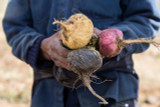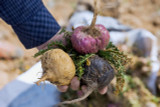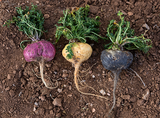All About The Maca Plant
By the time maca root reaches you, it’s undergone processing and is probably in either powder, capsule, or liquid form. In the US in particular, many consumers have grown distant from where their food is sourced. It’s easy not to think about where your food comes from and what exactly it’s made of. But if you’ve added maca to your diet, odds are you’ve made the decision to eat more conscientiously, and that means understanding what your food goes through before it makes it into your hands. So what exactly is maca root, and what happens to it before it gets to your kitchen?
What Is Maca?
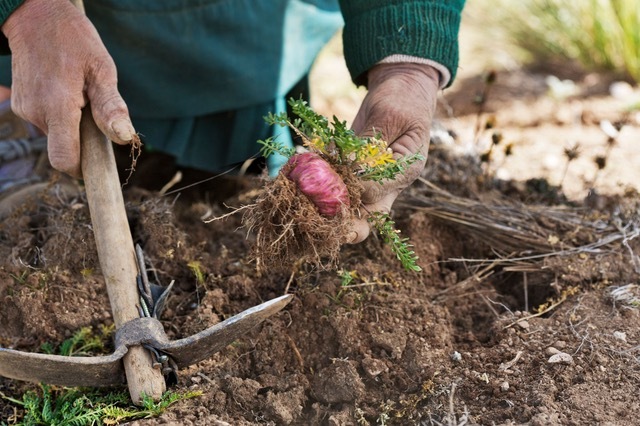
Maca (Lepidium meyenii) is a plant native to the Andes Mountains of Peru, where it’s been cultivated for thousands of years. Known for its ability to grow in harsh, high-altitude conditions, maca thrives at elevations of 12,000–14,000 feet above sea level. It’s a cruciferous vegetable, meaning it’s related to broccoli, cauliflower, and cabbage, though it looks more like a turnip or radish. The part of the plant that is consumed is the root, which can come in different colors, yellow, red, and black, each with its own unique benefits.
Maca root has long been valued by indigenous communities not just as a food source but also for its adaptogenic properties. Historically, it was used to promote stamina, fertility, and endurance. Today, maca is recognized worldwide for its nutritional density, containing essential amino acids, vitamins (such as B1, B2, C, and E), and a variety of minerals including calcium, potassium, and iron.
Where Maca Comes From
Authentic maca is grown almost exclusively in the highlands of Peru, particularly in the Junín and Pasco regions. The high elevation and mineral-rich volcanic soil contribute to maca’s unique nutritional profile. Because of the extreme climate conditions—cold nights, intense UV exposure, and thin air—the plant is forced to adapt and thrive, and those adaptations are what make maca such a resilient and nutrient-dense crop.
Maca farming in Peru remains largely traditional. Many growers use ancestral techniques passed down through generations, including hand planting, natural composting, and crop rotation. Harvest season typically begins in May and runs through August, once the maca roots have reached maturity after about 8 to 9 months of growth.
From Root to Powder: The Processing Journey
Once maca root is harvested, the journey from farm to table begins. The processing of maca can vary depending on the final product, but the general steps involve cleaning, drying, and grinding.
- Cleaning and Selection
After harvesting, the roots are thoroughly washed to remove dirt and debris. Farmers often sort the roots by color at this stage, as red, yellow, and black maca are typically processed separately to preserve their distinct properties. - Sun-Drying
Traditionally, maca roots are sun-dried for several weeks at high altitudes. This process not only preserves the root but also allows chemical changes to occur naturally that can enhance maca's potency. Drying maca in its natural environment is generally considered superior to artificial drying methods, as it retains more of the plant’s nutritional and adaptogenic compounds. An exception is our premium maca, which is dried in a low-temperature dehydrator, resulting in a higher presence of glucosinolates. - Grinding into Powder
Once dried, the roots are ground into a fine powder using specialized machinery. This powder is then sifted for consistency and quality. The end product, raw maca powder, is what many consumers are most familiar with. It has a malty, earthy flavor and is commonly added to smoothies, oatmeal, and baked goods. - Gelatinization
Some maca is processed further through a heat-based method known as gelatinization. Contrary to what the name suggests, this process doesn’t involve gelatin or animal products. Instead, it uses heat and pressure to break down starches in the maca, making it easier to digest. Gelatinized maca is a great option for individuals with sensitive digestive systems. - Capsules and Liquid Extracts
In addition to powder, maca is also available in capsules and as a concentrated liquid extract. Capsules simply contain powdered or gelatinized maca in pre-measured doses. Liquid extracts are created by soaking the dried maca in a food-grade solvent to pull out the active compounds. These extracts are highly potent and often used by those looking for a convenient, fast-absorbing option.
Sustainability and Ethical Sourcing
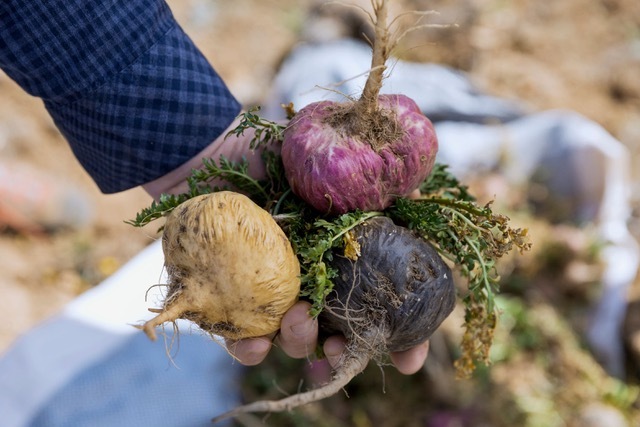
As maca’s popularity has grown globally, concerns around overharvesting and ethical sourcing have also emerged. Unfortunately, some maca on the market today is cultivated outside of Peru or processed using less traditional methods, which can affect both quality and potency. That’s why it’s important to purchase maca from reputable sources that work directly with Peruvian farmers and follow sustainable harvesting practices.
At The Maca Team, we prioritize working with small-scale, organic farms in the Peruvian Andes to ensure our maca is as pure and powerful as nature intended. Our roots are harvested by hand, dried in the sun, and processed using traditional methods to preserve the full nutritional integrity of the plant.
Why Knowing the Source Matters
Understanding where your maca comes from and how it's processed can help you make more informed choices and deepen your connection with what you consume. It’s not just about buying a food, it’s about supporting indigenous farming communities, preserving ancient agricultural wisdom, and nourishing your body with a root that’s survived and thrived for millennia.
So the next time you add maca to your morning smoothie or take a capsule before your workout, take a moment to think about the incredible journey that little root has taken, from the cold mountain soil of Peru to your hands.
Questions?
As purveyors of the highest quality maca on the market, we’ve worked hard to be a one-stop shop for information on maca root. We’ve collected everything from testimonials to verifiable scientific research on the effectiveness of maca root from a variety of reliable sources. Between our Maca FAQs and regular blog posts, we’re doing our part to help you make informed choices when choosing the right maca products to add to your diet. If you have any questions for us, please don’t hesitate to Contact Us using our web form, or call us toll-free at 888-919-8616.
Enjoy the Day!
Recent Maca Posts
-
Inside the Science of Adaptogens: What Makes Maca Stand Out
In today’s fast-paced world, many people are looking for natural ways to handle stress, boost energy …29th Oct 2025 -
What's the Best Maca for Me?
With so many maca options available, it’s easy to wonder which one is best for your specific needs. …28th Oct 2025 -
What Makes Maca Root a Superfood?
In recent years, the word “superfood” has become a staple in conversations about nutrition, wellness …24th Oct 2025


